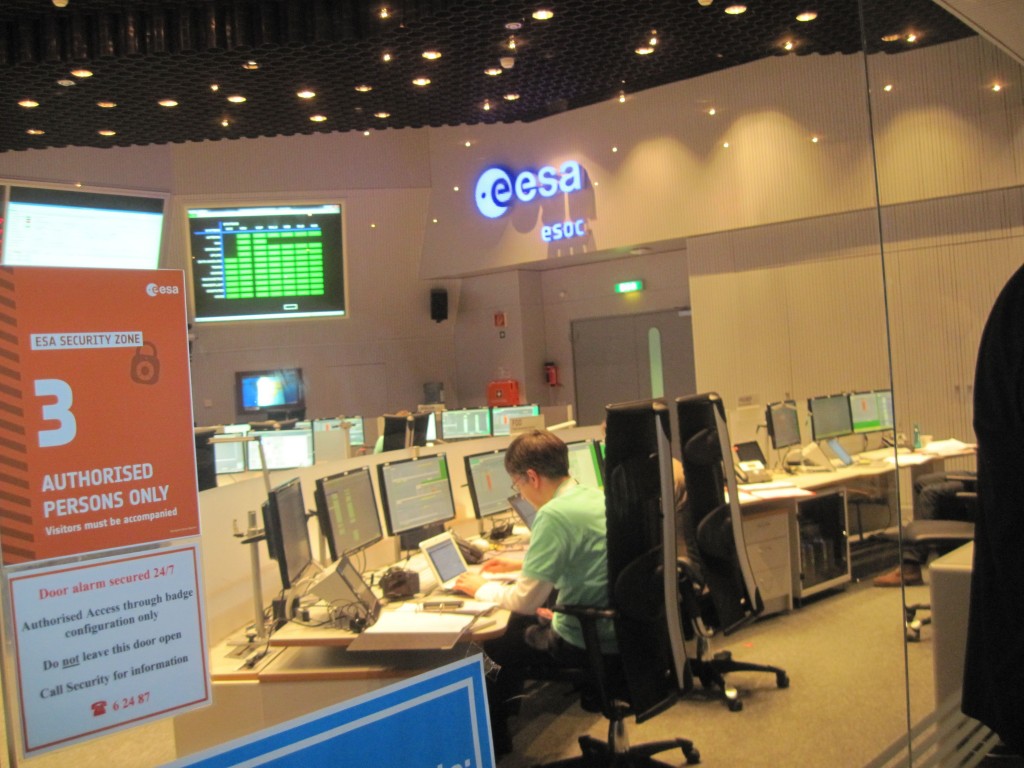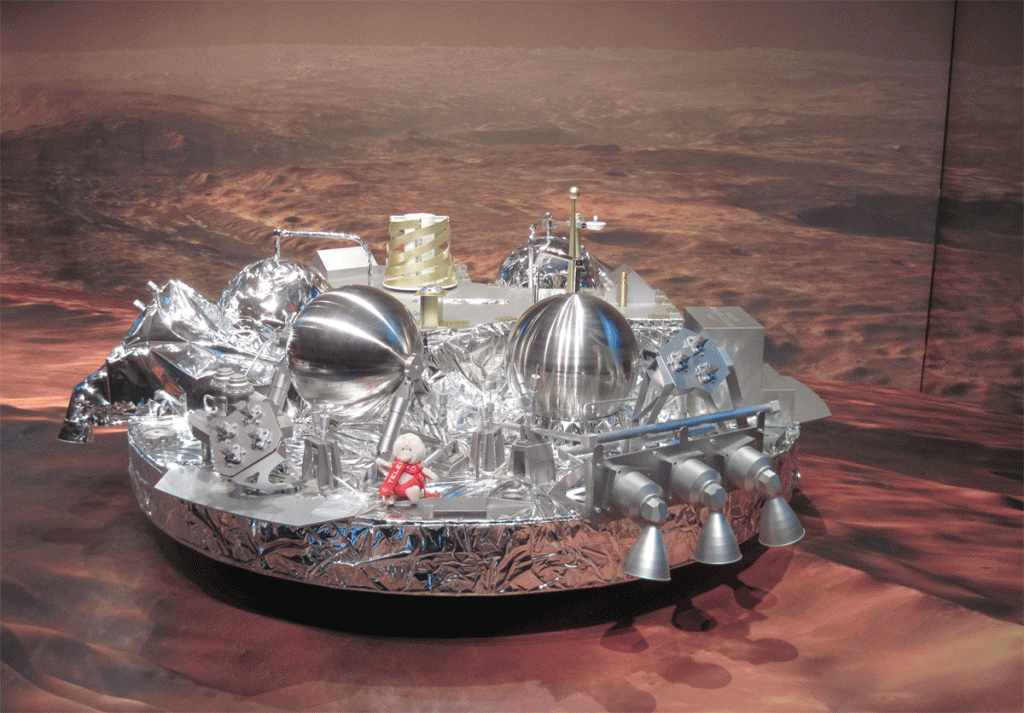Last week, we talked on the Facebook-Dependance of Virtual Astrobiology Society about the phantastic ExoMars 2016-Launch.
So David, Admin of Virtual Astrobiology Society, asked me, if I would like to write a personal article about it.
So, here it is!
Monday,14.10.2016 , 09:31, Pad 39 at Site 200 in Baikonur Cosmodrome,
Kazakhstan. The mighty Proton-M rocket with a Briz-M upper stage brought ExoMars 2016 on its way to Mars. Russian rockets start without a countdown, they just launch.
Lift off of Proton M with ExoMars 2016: Michael Khan (Mission Analyst) explainen launch and orbital mechanics (He calculated the flight trajectory!):
Here Michael wrote much more about the mighty Proton and ExoMars-launch.
10:31: Darmstadt. A not-so-large-City-in-Southern-Hessia in the Rhine Valley.
It is the home of ESOC – European Space Operations Centre.
So, Darmstadt is a little town, but it is the european space capital.
All unmanned flight operations of ESOC for whole Europe are planned, conducted and controlled from here. At this sunny day in march with ExoMars a new era of martian exploration starts.
Everybody, in the press rooms, control rooms and most offices, is watching the live TV coverage. Even via broadcast I can feel the deep roar of the starting Proton in my abdominal membrane. Then the rocket fades in the sky.
It´s gone.
I could hear, how people around me exhale, eased.
ExoMars 2016 is a very heavy space craft, it consists of TGM – Trace Gas Orbiter – and Schiaparelli-lander. So the Proton-upper stage has to orbit earth three times, every time with more speed in a larger orbit. Only this way it can reach the high velocity which is needed for its long way to the red planet, explains Mike McKay to me. He knows this – he is Mars Express Flight Director. And 500 million km are a long way.
ExoMars 2016 weighs 4332 kg: Trace Gas orbiter is about 3732 kg with 112 kg scientific payload, plus 600 kg for Schiaparelli with its heavy shield for the hot ride trough martian atmosphere.
It will take up to at least 21:13 h until ExoMars 2016 is separated from the upper stage. More than 10 hours!
So the day is filled with a program of presentations.
Martians are ….green!
My first “program”-point at this day was, to find my husband, Rainer Kresken. He is a an enthusiastic space engineer for astronomical research satellites, a dedicated amateur-astronomer and he can explain space-stuff for everybody. So at this day, he commented for the TV- and broadcasting-companies. His first interview was at 07:00 h in the morning, afterwards he commented for the Hessian TV-channel HR. He asked me, to bring him something. But: Where to find him? So I asked communication officer Andreas Schepers for help, he led me through the “staff-only-area” to main ExoMars control room. I was greeted at first by Paolo Ferri with a smile and warm handshake – he is head of Mission Operations for Rosetta. When he smiles, we have good start conditions. Rainer also smiled at me and then I went back to the main press area – into a mood like in a beehive. Media-teams and journalists from Europe and the USA, (the Russians have been there last week).
At these launch events I do not love only the program, but also the people: colleagues from all media, ESOC-staff and several “space-VIPs” – of course the former ESOC-director and ESA-astronaut Thomas Reiter could not resist to share this great event. Many of these people have to tell interesting stories. So I had a fascinating dialogue with Diego Urbina, a Marsonaut. He was one of two ESA crew-members of Mars500 and we talked about his experiences and goals. The short summary is: The team was great, food was a challenge and – of course – he would like to fly to Mars in real life. With a return ticket.
A special guided tour for press and social media gave us a look to ExoMars 2016 main control room: Shielded by large windows, the ExoMars 2016-staff was working. In the vestibule was a buffet with brain-food: Fruit, Snacks and a large box of dutch stroopwafels – with this support the mission must become successful!
Irritating were the presence of so many green shirts. Green? Normally ESA produces mission-shirts in white or three shades of blue, “MarsExpress” was red (!) and, o. k. Rosetta was turquoise. But green? This is a mission to the RED planet!
Nobody could explain me. The positive aspect: Mint and grass green shirts are flashy.
Behind ExoMars
Back to the large media-room I listened to “Behind ExoMars” – several presentations about the orbital mechanics and the background of ExoMars, the orbiter and lander, its landing technology, its instruments and the focus of the different parts.
ExoMars contains of two steps: ExoMars 2016 and, two years later, ExoMars 2018.
ExoMars 2016 is constructed of two components: the Trace Gas Orbiter (TGO) and the lander Schiaparelli. TGO shall sniff for trace gases like methane and works also as communication- and relais-Module, even for ExoMars 2018. For the research of trace gases ExoMars 2016 has 4 scientific instruments: ACS (Atmospheric Chemistry Suit), CaSSIS (Color and Stereo Surface Imaging System), FREND (Fine Resolution Epithermal Neutron Detector) und NOMAD (Nadir and Occultation for Mars Discovery).
Schiaparellis focus is not only scientific but also on the technical exploration of a soft landing. Schiaparellis former project name was EDM – Entry, Descent and Landing Demonstrator Module. It shall explore the technology for the entry in the martian atmosphere and a “soft” landing with parachute und retrorockets. Such a successful “soft” landing is the precondition for Exo Mars 2018 – the landing of a European mars-rover and a research-platform on the surface of the red planet.
Schiaparelli is named after the Italian astronomer Giacomo Schiaparelli, who “discovered” the mars canali and fired in 1877 the first mars-enthusiasm in Europe.
After the first Mars-photos some people were really disappointed.
Here are videos of the “Behind ExoMars”-presentations:
Michael Khan (mission analyst ExoMars): “Orbital mechanics and the journey to Mars”
Daniil Rodionov, Manish Patel and Gabriele Cremonese explain Scientific instruments on TGO: ACS, FREND; NOMAD and CASSIS.
Olivier Bayle (System engineer) explains entry, descent and landing demonstrator module:
Rolf de Groot (Coordinator Robotoc Exploration) recapitulates the not-so-easy- development of MarsExpress – this story began 2001! And he explains the importance of technical exploration with this mission.
Was there life on Mars?
For me, as a biologist, ExoMars is the most exciting ESA-mission ever, because its main focus is exobiology!
So Jorge Vago’s presentation was the most fascinating lection of the day, he is ExoMars Project Scientist and coordinates the astrobiological exploration.
4,3 – 4,4 billion years ago, Mars was very different – it had liquid water at the surface and a denser atmosphere. 3,8 billion years ago Mars lost its atmosphere. Today it is a cold planet with a very thin atmosphere.
But: Mars is one of the best candidates for life in our solar system!
At earth, we have in cause of plate tectonic and degradation processes no rocks from the very beginning of evolution of life in a good state. But on Mars they are! Not at the surface, but perhaps in the depth.
And MarsExpress told us, that there is methane in the Martian atmosphere.
On earth, 90 % of methane is produced by life-forms. Where does the methane of Mars stems from?
Possible methane sources are volcanism, meteorite dust, comet impacts, methane clathrates, microbes and serpentinization. MarsExpress also told us, that in ancient times there was some water on Mars, because of the extended regions with clays.
Phoenix found a surprising molecule: Perchlorate. This is a very important information, because, when perchlorates are heated, they destroy bio-molecules.
And whenever samples on Mars were investigated, they were heated.
So it is possible, that the perchlorate destroyed bio-molecules, which were in the samples.
Even Curiosity took samples of Mars´ surface and heated them for further research.
So, the absence of biomolecules on Mars can be an anthropogen induced artefact.
ExoMars 2018 will land a rover and investigate the martian surface. And it will investigate the samples without heating! So this can lead to other results.
At second, ExoMars 2018-rover will drill much deeper than ever: It will drill up to 2 m depth. This is the first search for biosignatures in such a depth – so it will collect samples from below the degradation horizon.
For more information please watch and listen Jorges presentation:
After this thrilling presentation I asked him: “How probable it is, to find traces of fossil life on Mars? What do you estimate?” Jorge answered: “50%!”
Wow! That´s much more than I expected. “Why do you expect such a high probality for fossil life?”
In former times Mars had an atmosphere, he answered me. And at this time it could have been habitable. “When we assume, that the conditions for the evolution in our solar system have been similar, so it is not too improbable, that there were lifeforms on early Mars.”
But we have to drill deep!
Further he explained to me, that they will land the rover in a place with traces of water. And they want to conduct the drilling in preferably old sediments. The age of the landing site must be estimated by the number of meteorite craters.
Further information you will get here:
Vago, J; et al: “ESA ExoMars program: The next step in exploring Mars”; Solar System Research 49(7):518-528 · December 2015; DOI: 10.1134/S0038094615070199
In the last session Simone Silvestro and Carlo Bettanini gave an overwiew about science on the Schiaparelli lander.
Here is a close up view of a Schiaparelli-model.
To be honest: It looks as if some children took lots of spacey alu-stuff and constructed a flying saucer.
But Simone Silvestro and Carlo Bettanini assured us, that this is highly functional space ship and will do a perfect job on the red planet. O. k., convinced.
The next official part is:
21:13: “earliest announcement of spacecraft separation” – done.
uuups? Not so spectacular.
Some summaries for the end…many people could not decide to leave.
22:55: A long, long day ends. Definitely.
Everybody is happy. ExoMars 2016 is on its way.
Now we are looking forward for the 19.10.2016 – then the spacecraft will arrive at Mars. After 500 Millions of Kilometers.
For Astrobiology-Fans ExoMars 2018 will become far more exciting.
At the very moment it is not sure, if Roskosmos will postpone the start, as Igor Komarov, der Roskosmos-Head, said to journalists in Baikonur at 13.03.2016: “The issue of the mission’s possible postponement to 2020 is being discussed but the final decision has not yet been taken”
We will see.
However, we will go to Mars and look for methane, life and fossil traces of life.
In 2018 or 2020.
For further reading:
ESA: ExoMars



Letzte Kommentare